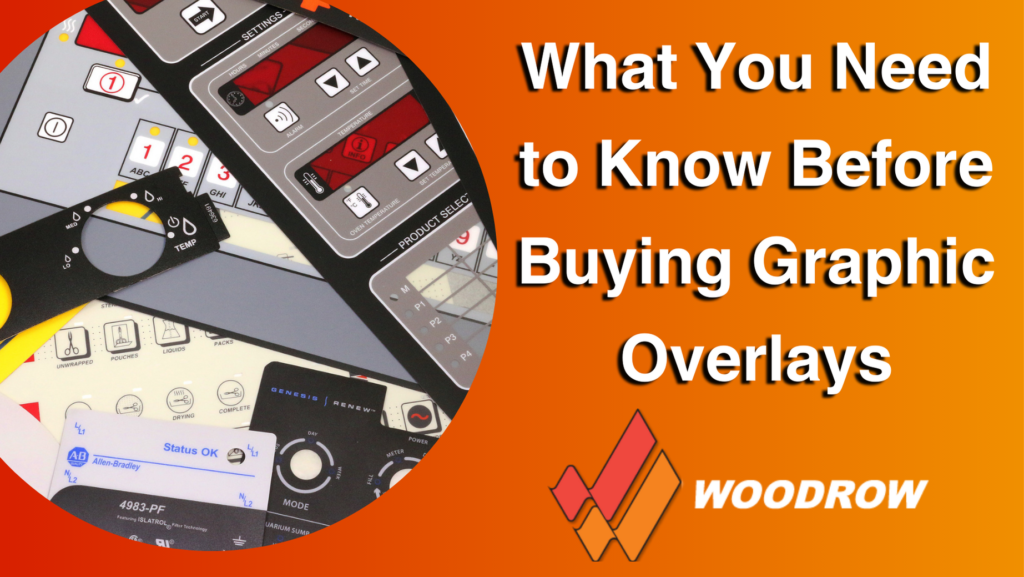
Graphic overlays are crucial in various industries, from electronics to medical devices and industrial equipment. These overlays serve as the interface between users and a device’s functionality, making them a critical component in product design. However, several key factors must be considered before diving into graphic overlays. In this blog post, we’ll explore what you need to know before purchasing to ensure you choose the suitable graphic overlays for your needs.
Selecting The Graphic Overlay Material
You can use multiple materials, each with pros and cons. Each material has different thicknesses, flexibility, and durability.
- VINYL: Many companies choose vinyl, as it is durable and economical. This material is also a good choice for signs and labels due to its flexibility and resistance to moisture and abrasion.
- POLYESTER: Polyester is valued for its strength, durability, and resistance to wrinkles and fading. It is also resistant to moisture and UV exposure and can retain high-quality graphics.
- CLEAR POLYCARBONATE: Clear polycarbonate is durable and popular for outdoor equipment and other demanding applications. Clear polycarbonate allows for the printing of sharp, high-resolution images.
- POLYPROPYLENE: Polypropylene is lightweight, resistant to moisture, and has good chemical resistance. While not as rigid as other materials, it shines in other durability aspects.
- POLYSTYRENE: Polystyrene is lightweight, rigid, and can be transparent or opaque. It also has low thermal conductivity and is very cost-effective.
Fitting
An important factor in buying a graphic overlay is whether it will fit. So, the type of cutting used is essential. The one used most is die-cutting. Die-cutting is a manufacturing process used to cut materials into specific shapes or designs using a specialized die tool. A die is a sharp-edged tool made from metal shaped according to the desired pattern. Die-cutting ensures accurate and consistent shapes across many overlays. Using dies with sharp edges ensures clean and smooth cuts on the overlay material. This is important for achieving a professional and polished appearance, especially in applications where aesthetics is crucial.
A digital cutter is a computer-controlled cutting device. A vector-based design is created in a software program (usually Adobe Illustrator or Corel Draw) and then sent to the cutter, which cuts along the vector paths laid out in the design. The cutter can move the blade on an X and Y axis over the material, cutting it into any shape imaginable. This process can be combined with digital printing and accommodate parts up to 54″ in width and 50′ long. Digital cutting enables easy customization of graphic overlays. With traditional cutting methods, designers can create unique shapes, sizes, and intricate patterns that might be challenging or impossible to achieve.
Resistance and Lifespan
Resistance and lifespan focus on how well the overlay guards against different types of friction and local elements. For instance, if you use the overlay in a setting with chemicals, you would want to use polypropylene. Still, if it is going to be in a physically harsher environment, vinyl would be better suited. You can see our list of materials above and see which suits your needs the best.
Laminates
Laminates are important in the final stages of the product. They add an extra layer of protection and improve the aesthetic of the overlay. Here at Woodrow, we provide high-quality lamination with multiple options.
Backlighting
Backlighting in graphic overlays is a design technique that strategically places light sources behind a transparent or semi-transparent overlay, enhancing the visibility and aesthetic appeal of the displayed graphics. This method is commonly employed in various industries, such as electronics, automotive, and industrial control panels, where visual clarity and readability are crucial. By incorporating backlighting, designers can create a striking visual effect, making the graphics and symbols on the overlay more prominent, especially in low-light environments.
LED technology is often utilized for backlighting due to its efficiency, durability, and flexibility. The controlled illumination improves the overall user experience and contributes to the overlay’s functionality by ensuring that important information is easily discernible, enhancing user interaction and satisfaction.
Regulation
Depending on your industry and application, specific regulatory standards and compliance requirements for graphic overlays may exist. Ensure that the overlays meet necessary safety, quality, and performance standards. This is particularly crucial in industries like medical devices and aerospace, where adherence to regulations is non-negotiable.
Adhesive
The adhesive in graphic overlays is essential for ensuring a secure bond to the substrate. It must withstand environmental conditions, temperature variations, and other stress factors. Additionally, consider whether the adhesive needs to be removable or permanent. Some applications may require overlays to be easily replaceable, while others demand a more permanent bond for long-term use.
